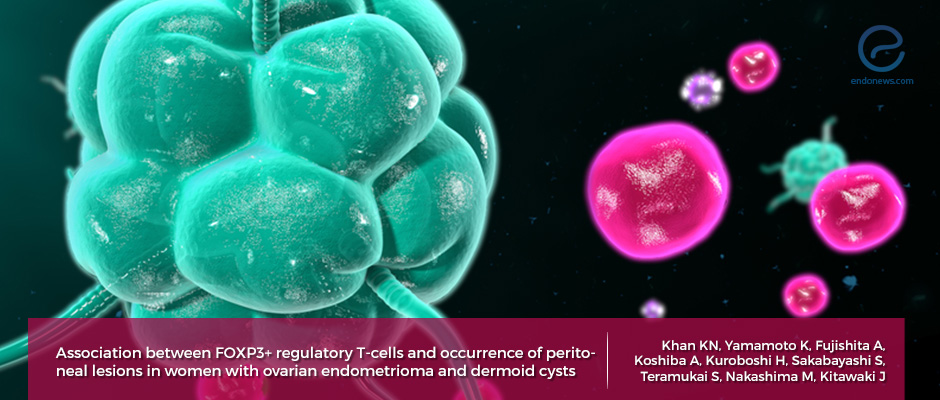Correlation between Treg cells and peritoneal lesions in women with ovarian endometrioma
Apr 26, 2019
Regulatory T-cells: the answer to peritoneal lesions
Key Points
Highlight:
- The alteration occurring in "Regulatory T cells (Treg)" causes survival and implantation of ectopic endometrial-like lesions in women with endometrioma.
Importance:
- Tregs are important because they have the capacity to suppress the immune response by promoting anti-inflammation activity, thus permit ectopic endometrial implantation and progression.
What's done here:
- This study is retrospective and prospective case-controlled cohort study, which collected peritoneal lesions from 27 and 25 women with ovarian endometrioma and dermoid cysts, respectively. Peritoneal fluid was also collected from 36 and 42 women with ovarian endometrioma and dermoid cysts.
- Tissue expression of Forkhead box P3 (FOXP3), a specific marker for Treg cells, and transforming growth factor-beta (TGF-β) were determined by immunohistochemistry.
- The levels of Interleukin-6 (IL-6) and TGF-β in the peritoneal fluid were measured by enzyme-linked immunosorbent assay.
Data:
- Peritoneal lesions coexist with ovarian endometrioma more frequently than dermoid cyst cases.
- Ovarian endometrioma and dermoid cysts peritoneal lesions have a higher number of Treg cells.
- Higher Treg cell numbers in pathological lesions corresponded with higher TGF-β and lower IL-6 levels in peritoneal fluid.
Limitation:
A number of limitations have been highlighted by the authors:
- the study did not evaluate the detection of general or disseminated deep infiltrating endometriosis in the pelvic cavity
- small sample biopsy size for the Treg cells analysis
- The study did not examine effector immune cells (Th17) which are regulated by TGF-β and IL-6.
Lay Summary
It is increasingly suggested that defective immune response is responsible for the survival and development of ectopic endometrial cells into endometriosis. In women with endometriosis, the immune system fails to create an inflammatory process that destroys endometrial cells at the ectopic site. One emerging research in this area is the role of a population of anti-inflammatory populations of T lymphocytes, called regulatory T (Treg) cells, which are potent immune response suppressor important to prevent immune destruction in all tissues.
A number of recent showed a higher number of Treg cells in the eutopic endometrium, peritoneal fluid and peripheral blood of women with endometriosis than women without endometriosis. However, no study has examined the pattern of Treg cells in peritoneal lesions collected from women with ovarian endometrioma or dermoid cysts.
This study published in "Reproductive Biomedicine Online" conducted by Khan et al. from the Department of Obstetrics and Gynecology, Graduate School of Medical Science, Kyoto Prefectural University of Medicine investigated Treg cells in these peritoneal lesions. The research group previously demonstrated significantly more pelvic pain in ovarian endometrioma with coexisting peritoneal lesion than those without peritoneal lesion. Thus, it is important to understand the role of Treg cells in the peritoneal lesions.
The study collected peritoneal lesions from 27 women with ovarian endometrioma and 25 women with dermoid cysts. In addition, peritoneal fluid was also collected from 36 and 42 women with ovarian endometrioma and dermoid cysts, respectively. The tissue expression of Forkhead box P3 (FOXP3), a specific marker for Treg cells and transforming growth factor-beta (TGF-β) were examined by immunohistochemistry. Levels of Interleukin-6 (IL-6) and TGF-β levels in the peritoneal fluid were measured by enzyme-linked immunosorbent assay.
The data showed that ovarian endometrioma with coexisting peritoneal lesions was more frequent than dermoid cyst with coexistent peritoneal lesions. Numbers of FOXP3+ Treg cells were higher in the peritoneal lesions of women with the coexistence of ovarian endometrioma and dermoid cysts than without. High FOXP3+ Treg cell numbers in peritoneal fluid of women with peritoneal lesions correlated with high TGF-β, and low IL-6 levels.
These findings concur with the current idea that endometriosis development is related to alteration in Treg cells.
Research Source: https://www.ncbi.nlm.nih.gov/pubmed/30981619
immune system inflammation

